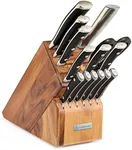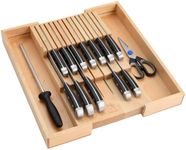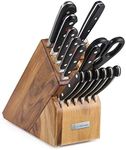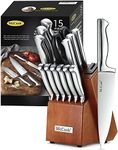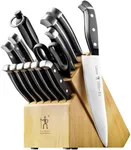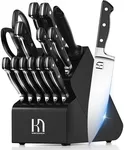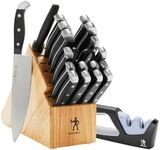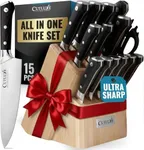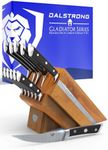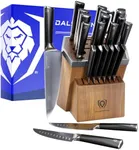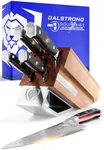Buying Guide for the Best Kitchen Knife Sets
Choosing the right kitchen knife set can make cooking much more enjoyable, efficient, and safe. A good set should include the types of knives you need most often, feel comfortable in your hand, and be built to last. Before choosing, think about your cooking habits—do you cook big family meals, chop lots of vegetables, or just need basics for occasional prep? It's important to look beyond looks: consider how you'll use each knife and how easy they are to care for. Investing a little time to understand key features will help you pick knives that are comfortable, sharp, and suited to your style of cooking.Blade MaterialThe blade material determines how sharp your knives stay, how easy they are to sharpen, and how resistant they are to rust. Common materials include stainless steel, carbon steel, and ceramic. Stainless steel is durable and low-maintenance, great for most home cooks wanting a reliable option. Carbon steel can get sharper and keep an edge longer, but it can rust if not properly cared for, so it’s best for those willing to do some extra maintenance. Ceramic knives stay sharp for a long time and don’t rust, but they can be more brittle and may chip if used on hard foods. Choose blade material based on how much care you're willing to give and whether you prioritize sharpness, durability, or ease of maintenance.
Number and Types of Knives IncludedA knife set can range from a few essential pieces to many specialized knives. Basic sets usually include a chef's knife, a paring knife, and a serrated/bread knife—each suited for different tasks like chopping, peeling, and slicing bread. Larger sets may add utility knives, santoku knives, and steak knives. Think about the types of food you prepare most often; if you rarely bake or carve, you might not need a bread or carving knife. It's better to have a few good, useful knives than a big set you won't use.
Handle Comfort and MaterialA knife's handle affects how comfortable and safe it is to use, especially for long periods. Handles come in materials like wood, plastic, or metal. Wood feels warm and offers good grip but needs more care to prevent cracking. Plastic handles are easy to clean but may get slippery when wet. Metal handles are durable but can feel heavy or cold. Try to choose a handle that feels sturdy in your hand and isn’t too big or small. If possible, hold some knives before buying to check comfort; otherwise, look for reviews that comment on hand-feel.
Balance and WeightBalance refers to how the weight is distributed between the blade and handle, affecting how the knife feels during use. A well-balanced knife helps reduce fatigue and offers better control. Some people prefer hefty, weighty knives for slicing through tougher foods, while others like lightweight knives for quick, agile chopping. The right weight for you comes down to personal comfort and the type of food you prepare most. If you struggle with hand or wrist fatigue, a lighter knife may be best.
Edge TypeKnife blades come with different edge types: straight (for clean slicing), serrated (for crusty bread or tomatoes), or granton (with small dimples to reduce sticking). Straight edges are versatile and easy to sharpen but need frequent touch-ups. Serrated knives stay sharp longer for specific tasks but are harder to sharpen. Granton edges work well for slicing meats and cheeses by preventing sticking. Consider what you'll be cutting most; if you bake often, look for a set with a serrated knife, but for all-around prep, straight edges are essential.
Storage and Safety FeaturesMost kitchen knife sets come with a storage solution such as a wooden block, magnetic strip, or an in-drawer tray. Good storage keeps knives organized, accessible, and protects the blades from damage. Blocks look attractive and are easy to use, but may take up counter space. Magnetic strips save space and make knives easy to grab, but require wall mounting. In-drawer trays keep counters clear but use valuable drawer space. Choose a storage option that fits your kitchen layout and helps keep knives safely out of reach of children.
Ease of MaintenanceSome knives are easier to care for than others. Stainless steel and plastic handles are often dishwasher-safe, but washing by hand will always help preserve sharpness. Knives with wooden handles or carbon steel blades generally need hand-washing and immediate drying to avoid damage or rust. If you prefer a low-maintenance set, look for dishwasher-safe options, but always remember that even the most durable knives will last longer with proper hand-care.


